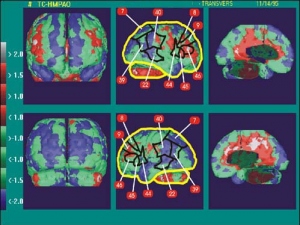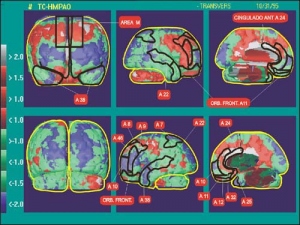Discussion of NeuroSPECT Results
NeuroSPECT scans are becoming extremely informative, as they show blood flow through areas of the brain. Blood flow implies function / activity(24,25). As noted, the autistic children have presented consistently with a decrease in blood flow in the temporal area, various degrees of hypoperfusion in the parietal / occipital area and the cerebellum vermis. There has often been an increase of blood flow in the frontal lobes which is consistent with ADD on the hyperactivity end. Figure 2.

The clinical implications of these findings has been heightened by the fact that the "anatomic" areas of the brain involved on the NeuroSPECT have correlated with predicted areas of dysfunction when reviewed by neuro-anatomists (research work in progress). In fact, the areas of dysfunction on Neuro-SPECT, have helped explain readily the physiologic dysfunction of these children.
These children present with a symptomatology consisting primarily of severe speech and language development (Left temporal lobe) and severe social difficulties (Right temporal lobe), often some fine, not usually gross, motor difficulties (cerebellar involvement), and various learning difficulties and attention deficit dysfunctions consistent with involvement of frontal and temporal lobes, and links to areas of parietal-occipital dysfunction. They may also have many symptoms consistent with OCD characteristics, associated with these areas of dysfunction.
In 1995, Mountz, Tolbert, Lill, Katholi and Liu reported their HMPAO findings in 6 children with severe autism and demonstrated with semi-quantitative techniques temporal and parietal hypoperfusion with lateralization to the left hemisphere, while in two of the three images published there is a maximal perfusion in the lateral frontal lobes.
Georges, Costa, Coniz, Ring and Ell reported in four autistic adults with Tc-99 HMPAO diminished rCBF in temporal and frontal lobes. The temporal abnormality appears to be confirmed mostly in adults, adolescents, and children suffering of autism. Thus, damage to temporal lobe in an early developmental stage may result in autistic manifestations.
The results are otherwise heterogeneous translating the heterogeneity of the autistic population, denoting the presence of occipital hypoperfusion and cerebellar hypoperfusion mostly in the mesial aspects corresponding to the vermis area. This later observation correlates with reports in the literature of atrophy of the cerebellar vermis demonstrated by MRI technique. Further heterogeneity in our group of patients is demonstrated by apparent comorbidity with OCD (and ADHD) in these children and their typical presentation of increased perfusion in lateral frontal lobes. (figure 3)


